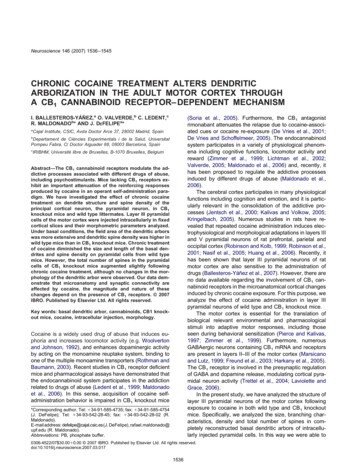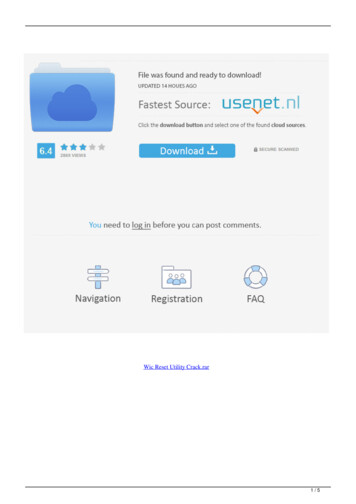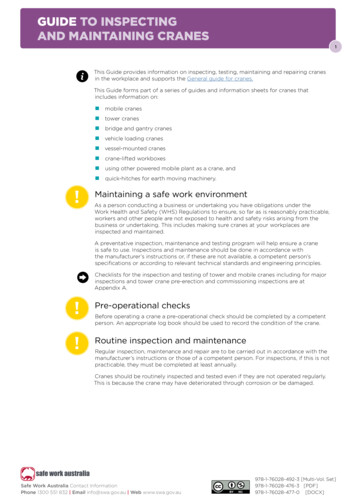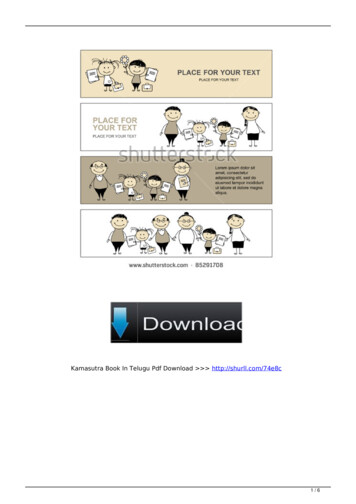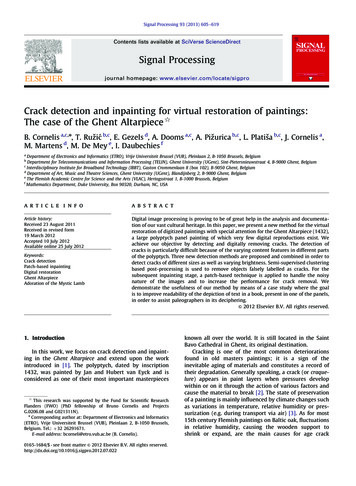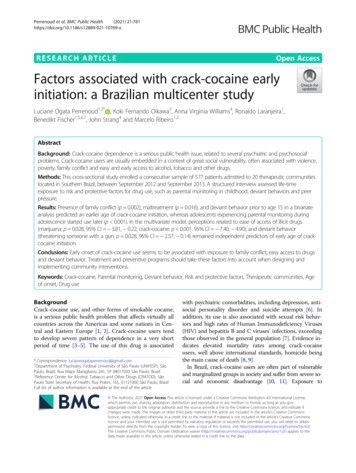
Transcription
Perrenoud et al. BMC Public Health(2021) SEARCH ARTICLEOpen AccessFactors associated with crack-cocaine earlyinitiation: a Brazilian multicenter studyLuciane Ogata Perrenoud1,2* , Koki Fernando Oikawa3, Anna Virginia Williams4, Ronaldo Laranjeira1,Benedikt Fischer1,5,6,7, John Strang4 and Marcelo Ribeiro1,2AbstractBackground: Crack-cocaine dependence is a serious public health issue, related to several psychiatric and psychosocialproblems. Crack-cocaine users are usually embedded in a context of great social vulnerability, often associated with violence,poverty, family conflict and easy and early access to alcohol, tobacco and other drugs.Methods: This cross-sectional study enrolled a consecutive sample of 577 patients admitted to 20 therapeutic communitieslocated in Southern Brazil, between September 2012 and September 2013. A structured interview assessed life-timeexposure to risk and protective factors for drug use, such as parental monitoring in childhood, deviant behaviors and peerpressure.Results: Presence of family conflict (p 0.002), maltreatment (p 0.016), and deviant behavior prior to age 15 in a bivariateanalysis predicted an earlier age of crack-cocaine initiation, whereas adolescents experiencing parental monitoring duringadolescence started use later (p 0.001). In the multivariate model, perceptions related to ease of access of illicit drugs(marijuana: p 0.028, 95% CI 3.81, 0.22; crack-cocaine: p 0.001, 95% CI 7.40, 4.90), and deviant behavior(threatening someone with a gun: p 0.028, 95% CI 2.57, 0.14) remained independent predictors of early age of crackcocaine initiation.Conclusions: Early onset of crack-cocaine use seems to be associated with exposure to family conflict, easy access to drugsand deviant behavior. Treatment and preventive programs should take these factors into account when designing andimplementing community interventions.Keywords: Crack-cocaine, Parental monitoring, Deviant behavior, Risk and protective factors, Therapeutic communities, Ageof onset, Drug useBackgroundCrack-cocaine use, and other forms of smokable cocaine,is a serious public health problem that affects virtually allcountries across the Americas and some nations in Central and Eastern Europe [1, 2]. Crack-cocaine users tendto develop severe pattern of dependence in a very shortperiod of time [3–5]. The use of this drug is associated* Correspondence: lucianeogataperrenoud@gmail.com1Department of Psychiatry, Federal University of São Paulo (UNIFESP), SãoPaulo, Brazil, Rua Major Maragliano, 241, SP 04017030 São Paulo, Brazil2Reference Center for Alcohol, Tobacco and Other Drugs (CRATOD), SãoPaulo State Secretary of Health, Rua Prates, 165, 01121000 São Paulo, BrazilFull list of author information is available at the end of the articlewith psychiatric comorbidities, including depression, antisocial personality disorder and suicide attempts [6]. Inaddition, its use is also associated with sexual risk behaviors and high rates of Human Immunodeficiency Viruses(HIV) and hepatitis B and C viruses’ infections, exceedingthose observed in the general population [7]. Evidence indicates elevated mortality rates among crack-cocaineusers, well above international standards, homicide beingthe main cause of death [8, 9].In Brazil, crack-cocaine users are often part of vulnerableand marginalized groups in society and suffer from severe social and economic disadvantage [10, 11]. Exposure to The Author(s). 2021 Open Access This article is licensed under a Creative Commons Attribution 4.0 International License,which permits use, sharing, adaptation, distribution and reproduction in any medium or format, as long as you giveappropriate credit to the original author(s) and the source, provide a link to the Creative Commons licence, and indicate ifchanges were made. The images or other third party material in this article are included in the article's Creative Commonslicence, unless indicated otherwise in a credit line to the material. If material is not included in the article's Creative Commonslicence and your intended use is not permitted by statutory regulation or exceeds the permitted use, you will need to obtainpermission directly from the copyright holder. To view a copy of this licence, visit http://creativecommons.org/licenses/by/4.0/.The Creative Commons Public Domain Dedication waiver ) applies to thedata made available in this article, unless otherwise stated in a credit line to the data.
Perrenoud et al. BMC Public Health(2021) 21:781violence and situations of abuse have also been associatedwith crack-cocaine use [7].The first experience with crack-cocaine usually occursin the transition to adulthood, often following the exposure to alcohol, tobacco, marijuana and snorted cocaine [4,12]. According to Substance Abuse and Mental HealthServices Administration (SAMHSA), crack-cocaine firstuse generally occurs between the ages of 18 and 25 in theUnited States [13]. Likewise, a study with homeless people(n 203) from Montreal, Canada, found that the age ofonset of cocaine use and its presentations, such as crackcocaine, happened after 17 years of age [14]. The II Brazilian National Alcohol and Drugs Survey (BNADS) foundthat the mean age of initiation for cocaine consumption inBrazil was 18.8 years [15]. Another survey with Braziliansadolescents in treatment found that the mean age at firstuse of crack-cocaine was 13.3 years [4].The age of onset of drug consumption is influenced bynumerous combinations of protective and risk factors,within a system that integrates social environments, relationships, individual characteristics and behavioral patterns [4, 16]. Longitudinal studies with psychoactivesubstances users have shown that the earlier the age ofonset of alcohol and tobacco use the greater the likelihood of developing drug addiction, more severe druguse patterns and more problematic deviant behaviors[14, 16]. Therefore, assessing the risk factors related tothe early age of drug use initiation could help to planand implement preventive strategies [17].Many risk factors for drug use initiation are part of acomplex and multifaceted framework which involves aninterplay of genetic, psychological and social factors [18–21]. Individual and personality factors such as curiosity,impulsivity and sensation seeking are common in adolescence [22–24]. In addition, the perception of easy access isstrongly related to the risk of starting psychoactive substances use [25]. Use of drugs by parents, family conflictand peer pressure also appear to be associated with futureproblematic drug use [17, 19, 26, 27]. The Brazilian National Survey of Crack-Cocaine Users [28] found that themain reasons for first crack-cocaine use were curiosity(58.3%), followed by family conflicts (29.2%) and influenceof friends (26.7%).Studies evaluating adolescent alcohol use suggest thatparents monitoring their children’s routine and expressing disapproval of drug use are protective factors forboth: early onset and binge drinking [21, 29, 30]. In contrast, children with parents who drink or are permissivein relation to drug use appear to have an early onset ofsubstance use, suggesting that early patterns of use maybe influenced by social and familial environmental factors [17–20].More recently, cross-sectional and longitudinal studies,assessing predictors of early initiation of crack-cocainePage 2 of 13use, found an association with sociodemographic factors,psychiatric comorbidities and previous use of any drug[4, 31–33]. Other studies investigated specific populations - for example, adolescents in street situations [14],however few multicenter studies focused on crackcocaine users. To our knowledge, this if the first multicenter study in Brazil assessing risk and protective factors for early onset of crack-cocaine use with patientsfrom Therapeutic Communities (TCs) who identifiedcrack-cocaine as the substance that made them seektreatment.MethodsSettingThis is a cross-sectional study which included TCs (n 20) affiliated with the Brazilian Federation of Therapeutic Communities (FEBRACT), which aims to trainthe Brazilian TCs according to the recommendations ofthe World Federation of Therapeutic Communities(WFTC). All TCs were registered with the Brazilian National Secretariat for Drug Policy (SENAD) and compliant with Brazilian Health Regulatory Agency (ANVISA)standards [34], this guaranteed the inclusion of studyparticipants from TCs with similar standards of treatment. The following inclusion criteria were chosen to select the institutions: (1) at least 10 years of existence and(2) having a qualified and regularly trained health team.Only voluntary admissions were allowed in the includedTCs; all patients who needed intensive medical/psychiatric care were referred to another health service. Thegeographic distribution of TCs are shown in Fig. 1. Thestudy was restricted to the south region of Brazil due tologistic issues (e.g. internet access and professional stafftraining). The period of recruitment was 05 September2012 to 05 September 2013.ParticipantsDuring the 12-month period of the study, a total of 1341individuals presented at one of 20 TCs with a substanceuse disorder. Of those, 719 crack-cocaine users were voluntarily admitted with the diagnosis of crack-cocaineuse disorders (F14.2) in accordance with the International Classification of Diseases 10th (ICD-10) [35].Among those, twenty-five patients (3.5%) refused to participate, while another 117 (16.3%) signed the consentform but interrupted treatment almost immediately,leaving at the end 577 (80.2%) patients eligible to participate in the study.InstrumentsA detailed structured interview was developed to be usedin this survey (in supplementary file). It was designed toobtain baseline data on factors associated with crackcocaine early initiation and other related behaviors, as
Perrenoud et al. BMC Public Health(2021) 21:781Page 3 of 13Fig. 1 Brazilian political map showing were the 20 therapeutic communities involved in the current study are located. The Map of Brazil was obtainedthrough the public domain website: http: orm.jsp, and the Apple Keynote software was usedfor the figure artwell as information about parental monitoring in childhood, peer pressure and deviant behaviors. To organizethe information collected and to formulate questions intune with the international literature, we selected threestructured questionnaires widely used in other studies.Sociodemographic data was selected from the MaudsleyAddiction Profile (MAP) questionnaire [36], a brief research instrument developed in the United Kingdom,assessing four domains: substance use, health risk behavior, physical and psychological health, and personal/social functioning.The questions on “parent relationship” (Table 1), “parent monitoring” (Table 2), and “perceptions related toeasiness in accessibility and permissiveness of drug consumption” (Table 3) were extracted and translated fromthe Kenneth Kendler’s Life History Calendar Interview(from Stress and Coping Project, Medical College of Virginia) [17, 20]. Finally, questions on “deviant behaviors”(Table 4), were extracted and adapted from either theDrug Abuse Treatment Outcomes Study (DATOS) questionnaire [37] or from the referred Kendler’s interview.Participants were asked to recall the above issues considering three age periods: 8 to 11 (middle childhood),12 to 14 (early adolescence) and 15 to 17 (middle adolescence), as previously used by Kendler’s study group[25]. Middle childhood is a period marked by progressiveindependence from parents, greater concern with the future and stronger and more complex friendships andpeer relationships. It is a critical period for the development of trust and intimacy outside the family circle among friends in the neighborhood, at school andduring sports practice. A rapid development of cognitiveskills allows children to develop a sense of responsibilityand learn more elaborate ways to communicate theirideas and feelings. Early adolescence is characterized byrapid growth and body changes, including genital
Perrenoud et al. BMC Public Health(2021) 21:781Page 4 of 13Table 1 Family relationships (n 577)CharacteristicN (%)Average ageof first crack useSD (CI 95%)P-valueaAdjusted p-valuebLived continuously with his/her mother until 17 years old (n 541)Yes389 (71.9)21.96.86 (19.5–21.7)No152 (28.1)20.66.98 (21.2–22.6)0.061-cUntil the age of 17, did you experience serious relationships problems with your mother for at least one month? (n 387)Yes143 (36.9)20.56.36 (19.4–21.5)No244 (63.1)22.77.22 (21.8–23.6)0.0020.4660.001-cLived continuously with his/her father until 17 years old (n 544)Yes292 (53.6)22.57.06 (21.7–23.3)No252 (46.4)20.36.38 (19.6–21.1)Until the age of 17, did you experience serious relationships problems with your father for at least one month? (n 291)Yes123 (42.1)20.95.73 (19.9–21.7)No168 (57.9)23.67.73 010.2100.4910.620From 8 to 18, how often did your parents or stepparents yell at each other? (n 415)Never / rarely / sometimes298 (71.8)22.26.91 (20.8–23.6)Often117 (28.2)21.86.54 (20.6–23.0)From 8 to 18, how often did your parents or stepparents physically assaulted each other? (n 417)Never / rarely / sometimes272 (89.2)22.16.97 (21.3–23.0)Often45 (10.8)21.96.89 (19.8–24.0)Have you witnessed fights with physical aggression between parents or caregivers? (n 539)Yes236 (43.8)20.86.32 (20.0–21.6)No303 (56.2)22.17.39 (21.2–22.9)Did your father have trouble related to alcohol consumption? (n 555)Yes297 (53.5)20.66.47 (19.9–21.3)No258 (46.5)22.67.48 (21.7–23.5)Did your mother have trouble related to alcohol consumption? (n 546)Yes82 (15)21.17.22 (19.5–22.7)No464 (85)21.77.03 (21.1–22.4)During childhood or adolescence, have you ever felt yourself extremely mistreated – without food, shelter, medical care and deprived of your basicphysical and emotional needs? (n 570)Yes106 (18.5)20.16.52 (18.9–21.4)No464 (81.5)21.97.08 (21.3–22.6)0.0160.3090.0010.185During childhood or adolescence, have you ever run away from home during the night? (n 569)Yes213 (37.4)20.46.87 (19.5–21.3)No464 (62.6)22.37.00 (21.6–23.0)SD standard deviation. CI confidence Interval. Significant results (p 0.05) are boldedat-test for independent variablesbANOVA, analyses adjusted by Bonferroni testcVariables that are no longer binary after ANOVAdevelopment, which inspires curiosity and increasingfeelings for privacy. Early adolescents thinking works essentially in a concrete way - “right-or-wrong thinking” and it is structured partly from the idea of being alwaysjudged by their peers. During middle adolescence thephysical changes may be nearly completed. The interestfor romantic and sexual relationships and the issues considering sexual identity progressively come to occupythe forefront of the teenagers’ lives. More elaboratedforms of argumentation and more independent posturesof life are usual at this stage. Adolescents between 15and 17 years spend less time with family and more timewith friends - peer pressure may peak at this stage. Abstract thinking, complex decision making, impulse control and capacity for otherness start to develop duringthis period [38, 39]. There are consistent research
Perrenoud et al. BMC Public Health(2021) 21:781Page 5 of 13Table 2 Parent monitoring through late childhood and adolescenceDid yourparents /caregiversreally know:8–11 years (n 542)12–14 years (n 526)No AlittleNo 76)20.0–21.2VerywellPAdjusted pvaluea valueb15-17 years (n 483)No 22.4370 618.9–21.6PvalueaAdjusted pvaluebPAdjusted pvaluea valuebWho your friends were?N (%)282 (52)260(48)Averageage (SD)20.9(6.42)22.5(7.44)CI 95%20.1–21.621.6–23.40.0080.392 0.0010.0970.3710.725How you spent your money?1N (%)157(43.2)207(56.8)Averageage (SD)22.4(7.78)21.2(6.39)CI 95%21.2–23.720.4–22.10.1130.768 0.0010.0610.4230.444Where you used to go in your spare time?N (%)250(46.2)291(53.8)Averageage (SD)20.6(6.38)22.6(7.39)CI 95%19.8–21.321.8–23.50.0010.503 0.0010.0230.0590.856(1) 178 participants between 8 and 11 years of age, 53, between 12 and 14 years of age and 8 between 15 and 18 years of age reported no access to money at allby that timeSD Standard deviation. CI Confidence Interval. Significant results (p 0.05) are boldedat-test for independent variablesbANOVA, analyses adjusted by Bonferroni testpointing that parental monitoring have different effectson child and adolescent behaviors, considering these agegroups [40–46].ProceduresThis structured interview had been extensively pilottested beforehand. The pilot tests were carried out 1month prior to data-collection, first among the researchers and then among the interviewers. Finally, aspart of the pilot test phase, the interviewers conductedthe structured interview with at least one recently admitted patient. All interviewers (n 41) were health professionals - psychologist, social worker or nurse. Theinterviewers were trained locally by at least one memberof the research group (n 6). Remote assistance was offered for the interviewers to clarify any questions priorto launch of data-collection.Interviews were conducted within the first 15 days following treatment admission. The interview day was decided based on an assessment of the participant’scondition, such as clinical status, abstinence syndrome,treatment adherence, willingness to be interviewed thattime/day, among others. Interviews were conducted in aprivate room, in front of a computer, side by side withthe patient, during two consecutive days and each ofthem lasting about 1 h and a half.The interview and the adopted scales were incorporatedinto an electronic research data platform (Sphinx iQ2 )allowing real-time data entry and storage in an onlinedatabase. The structured interview followed a pre-definedsequence and comprised multiple choice questions. Theonline platform was programmed to prevent invalid orunfilled responses, this guaranteed the standardization ofthe interview and avoided missing data. In order to monitor the quality of data collection, a member of the studyteam was designated to each study site and was responsible for verifying each new entry, as well as, for visitingthe TC at least twice during the study period.Statistical analysesTo test differences between characteristics according tocrack-cocaine early use, we used Student t-test for comparisons between groups. The t-test is implementedwhen the population variance, σ2, is generally unknown,and in this case, the sample variance, s2, is used and thep-value of the test will allow us to assess whether theaverage age difference for the beginning of crack-cocaineis significant at the 0.05 level. For each table, each
Perrenoud et al. BMC Public Health(2021) 21:781Page 6 of 13Table 3 Perceptions related to easiness in accessibility and permissiveness for consumptionBetween 15 and 17, how easily did you get:Very easy EasyHard Very hardCigarettes (tobacco) (n 564)557 (98.7)7 (1.3)Average age (SD, CI 95%)21.5 (6.89, 20.9–22.0)24.0 (11.61, 11.8–36.1)Alcohol drinks (n 564)547 (97)17 (3)Average age (SD, CI 95%)21.4 (6.82, 20.8–22.0)25.5 (9.80, 20.3–30.7)Marijuana (n 561)501 (89.3)60 (10.7)Average age (SD, CI 95%)20.9 (6.62, 20.3–21.5)26.8 (7.52, 24.8–28.7)Cocaine (“snorted”) (n 560)388 (69.3)172 (30.7)Average age (SD, CI 95%)20.1 (6.24, 19.4–20.7)24.9 (7.36, 23.8–26.0)P-valueaAdjusted p-valueb0.3820.1280.0200.441 0.0010.001 0.0010.816Crack cocaine (n 559)221 (39.5)338 (60.5)Average age (SD, CI 95%)17.1 (4.21, 16.5–17.6)24.5 (6.87, 23.7–25.2) 0.001 0.001During childhood and adolescence, did your parentsor caregivers find normal an adolescent:Yes PartiallyNoP-valueaAdjusted p-valuebTo smoke cigarettes (tobacco)? (n 519)131 (25.2)388 (74.8)Average age (SD, CI 95%)20.9 (7.17, 19.7–22.1)22.0 (6.81, 21.3–22.7)0.1090.192To drink alcoholic beverages? (n 520)154 (29.5)366 (70.5)Average age (SD, CI 95%)21.4 (6.72, 20.3–22.4)21.9 (6.96, 22.1–22.6)0.4680.866To get drunk? (n 520)70 (13.4)450 (86.6)0.0470.949Average age (SD, CI 95%)21.2 (6.95, 19.6–22.9)21.8 (6.90, 21.2–22.5)To smoke marijuana? (n 521)18 (3.4)503 (96.6)Average age (SD, CI 95%)20.7 (7.34, 17.0–24.3)21.8 (6.89, 21.2–22.4)0.4980.783During childhood / adolescence, how often didyour parents / caregivers:Almost everyday WeeklyMonthly NeverP-valueaAdjusted p-valuebSmoke cigarettes (tobacco) (n 519)380 (73.2)139 (26.8)Average age (SD, CI 95%)22.0 (7.17, 21.3–22.8)20.8 (6.05, 19.8–21.9)0.0810.063Drink alcoholic beverages (n 521)299 (57.3)222 (42.7)Average age (SD, CI 95%)21.7 (6.64, 20.9–22.4)21.8 (7.24, 20.9–22.8)0.7990.366Get drunk (n 519)187 (36.1)332 (63.9)Average age (SD, CI 95%)20.9 (6.19, 20.0–21.8)22.2 (7.22, 21.4–23.0)0.0470.034Smoke marijuana (n 516)48 (9.2)468 (90.8)Average age (SD, CI 95%)20.5 (6.52, 18.6–22.4)21.9 (6.94, 21.2–22.5)0.1980.337Snorted cocaine (n 515)28 (5.4)487 (94.6)Average age (SD, CI 95%)19.8 (4.99, 17.8–21.7)21.9 (7.01, 21.2–22.5)0.1220.471Between 15 and 17, how many friends of yours used to:Nobody A few SomeMajority EverybodyP-valueaAdjusted p-valuebSmoke cigarettes (tobacco) (n 557)216 (38.7)341 (61.3)0.0010.019Average age (SD, CI 95%)22.6 (6.97, 21.7–23.6)20.7 (6.77, 20.0–21.5)Drink alcohol (n 557)201 (37)356 (63) 0.0010.027Average age (SD, CI 95%)23.3 (7.57, 22.3–24.4)20.4 (6.27, 19.8–21.1)Get drunk (n 557)264 (47)295 (53) 0.0010.837Average age (SD, CI 95%)22.9 (7.27, 22.0–23.8)20.2 (6.29, 19.4–20.9)Have problems related to alcohol use (n 553)324 (58.5)229 (41.5) 0.0010.928Average age (SD, CI 95%)22.5 (7.32, 21.7–23.4)20.0 (5.99, 19.3–20.8)Smoke marijuana (n 556)283 (50.9)273 (49.1) 0.0010.109Average age (SD, CI 95%)23.0 (7.07, 22.2–23.8)19.9 (6.36, 19.1–20.6)Smoke crack cocaine (n 555)498 (89.7)57 (10.3) 0.001 0.001Average age (SD, CI 95%)22.2 (6.84, 21.6–22.8)15.4 (3.89, 14.4–16.4)SD Standard deviation. CI Confidence Interval. Significant results (p 0.05) are boldedat-test for independent variablesbANOVA, analyses adjusted by Bonferroni test
Perrenoud et al. BMC Public Health(2021) 21:781Page 7 of 13Table 4 Deviant behaviorCharacteristicN (%)Average age offirst crack useSD(CI 95%)Until the age of 15, have you ever threatened someone with a gun?(n 567)Yes172 (30.3)19.45.8 (18.5–20.2)No395 (69.7)22.57.3 (21.8–23.3)Until the age of 15, have you ever hurt an animal on purpose – out ofhunting (n 566)Yes198 (35)21.16.5 (20.2–22.0)No368 (65)21.87.3 (21.1–22.6)Yes406 (71.7)21.16.8 (20.4–21.8)No160 (28.3)22.87.5 (21.6–24.0)Until the age of 15, did you use to tell many lies? (n 566)Until the age of 15, you used to steal things from stores, childrenor your parents (n 566)Yes283 (50)20.56.2 (19.7–21.2)No283 (50)22.77.6 (21.8–23.6)Until the age of 15, have you ever assaulted a child to the pointof sending him to the hospital? (n 565)20.9Yes141 (25)No424 (75)21.8PvalueaAdjustedp-valueb 0.0010.0500.0050.3927.2 (19.7–22.1)7.0 (21.1–22.5)Until the age of 18, have you been in a youth detention center?(n 571)Yes95 (16.6)19.07.2 (21.5–22.7)No476 (83.4)22.16.0 (17.8–20.3)Until the age of 18, have you been in a youth detention centerfor at least 3 months? (n 570)Yes32 (5.6)18.24.2 (16.7–19.7)No538 (94.4)21.77.1 (21.1–22.3)SD Standard deviation. CI Confidence Interval. Significant results (p 0.05) are boldedat-test for independent variablesbANOVA, analyses adjusted by Bonferroni testcategorical variable’s t-test was used to compare theaverage age at onset of crack-cocaine use by respondentswho answered “yes” or “no” to each question. Analysis ofvariance (ANOVA) were used to compare the results ofthe variables provided in each table. Due to the multiplecomparisons, Bonferroni tests were performed for statistical adjustment in regard to all variables. Subsequently,to test the independent effect of the risk and protectivefactors associated with early crack-cocaine initiation, amultiple linear regression model was performed onlywith variables that remained significant after Bonferroni’s adjustment. All analyses were conducted using theSTATA, version 13.1.ResultsSociodemographic data of this study have been published in detail elsewhere [47]. Study participants weremainly male (n 517, 89.6%), living alone (single, divorced or widow) (n 448, 78.4%), with and average ageof 30.8 years (SD 7.7). Three-quarters (73.9%) were 34years old or younger. They had a medium of 11.8 schoolyears (SD 4.4). Aspects related to religiosity have alsoalready been published [48]. Average age of first use ofcrack-cocaine was 21.5 years (SD 7.0).Family relationshipsQuality of the relationships, neglect, maltreatment andviolenceNone of the variables in this subgroup reached significance after Bonferroni’s corrections – some of themreached only a nominally significant difference, considering the average age of onset of crack-cocaine use between groups. A significant earlier onset of crackcocaine use was observed when the father had problemswith alcohol use (p 0.001; Bonferroni corrected p 0.210) or when the participant had a constant relationship conflict with the mother (p 0.002; Bonferroni corrected p 0.466) or the father (p 0.001). The presence
Perrenoud et al. BMC Public Health(2021) 21:781of an extremely severe maltreatment episode duringchildhood or adolescence (p 0.016; Bonferroni corrected p 0.309) or escaping home at night during thesame period (p 0.001; Bonferroni corrected p 0.185)were related to early use of crack-cocaine. In addition,having witnessed physical aggression among the parentsshowed an association (p 0.038).Page 8 of 13- tobacco (p 0.001; Bonferroni corrected p 0.019), alcohol (p 0.001; Bonferroni corrected p 0.027),marijuana (p 0.001; Bonferroni corrected p 0.109), aswell as for patterns of consumption - to get drunk, problematic alcohol use (p 0.001, for both cases; Bonferronicorrected p 0.837 and p 0.928, respectively) - therewere significant differences only in the results of the Student t test analyses (Table 2).Parent or caregiver monitoringA similar scenario occurred with the variables on parental monitoring after Bonferroni’s adjustments (Table 4).Only the variable related to monitoring of spare time inthe 12 to 14 year old period remained significant as aprotective factor for later age of onset of crack-cocaineuse (p 0.001; Bonferroni corrected p 0.023). Theother variables showed differences only in test t-Studentanalyzes. The study patients whose parents knew theirfriends (p 0.008; Bonferroni corrected p 0.392) andknew how they spent their free time when they were 8–11 years old (p 0.001; Bonferroni corrected p 0.503)started crack-cocaine consumption later. These same actions of parental monitoring added to the control of respondents’ expenses in early adolescence (12–14 years),remained associated as protective factors for the age ofonset of crack-cocaine consumption (p 0.001, for allvariables; Bonferroni corrected p 0.097; p 0.023 andp 0.061, respectively). However, parental monitoringwas no longer a factor related to early age of onset from15 years old onwards.Accessibility and drug use permissiveness by parentsPerception related to easiness in accessibility forconsumptionDuring adolescence, the perception related to easy accessibility of marijuana (p 0.001; Bonferroni corrected p 0.001) and crack-cocaine (p 0.001, for both analyses)remained statistically significant after Bonferroni’s adjustments (Table 2).Permissiveness of alcohol, tobacco and drug use at homeThe results showed that parents finding “normal” fortheir children, as well as for themselves, to use alcohol,tobacco and marijuana anywhere was not a predictivefactor for early initiation of crack-cocaine use (Table 2).An association was observed between those reportinghaving parents who got drunk daily/weekly and usingcrack-cocaine early (p 0.047; Bonferroni corrected p 0.034).Peer factorsHaving the “majority/all” of friends using crack-cocainewas associated with early crack-cocaine use, and this association remained significant after Bonferroni’s correction (p 0.001). For the other types of drugs investigatedDeviance behavior and contact with youth justice system(before 15 years old)Reporting to have threaten someone with a gun beforethe age of 15 showed a significant interaction effect withthe age of onset of crack-cocaine use (p 0.001; Bonferroni corrected p 0.001). Telling many lies (p 0.008;Bonferroni corrected p 0.484) and steal stores or theirparents (p 0.001; Bonferroni corrected p 0.011), aswell as, having been in a detention center (p 0.001;Bonferroni corrected p 0.050), regardless of theamount of time (p 0.005; Bonferroni corrected p 0.392) were significant only for the results of the Studentt test analyses.Risk and protective factors associated with initial crackcocaine useIn the multivariate model (Table 5) variables were selected using the statistical criteria explained above (i.e.,those remaining significant after Bonferroni’s adjustment): parental monitoring of places where the patientsspent their free time during ages of 12–14 years, perceptions related to ease access to get marijuana and crackcocaine during adolescence, frequency of drunkenness ofparents or caregivers, having peer crack-cocaine users inadolescence, and deviant behavior (e.g., threateningsomeone with a g
A detailed structured interview was developed to be used in this survey (in supplementary file). It was designed to obtain baseline data on factors associated with crack-cocaine early initiation and other related behaviors, as Perr


